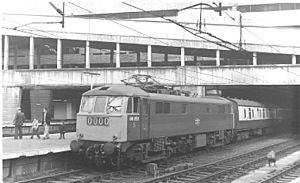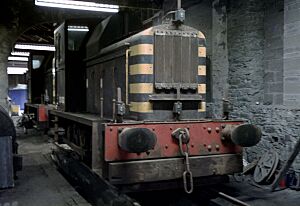Route availability facts for kids



Route Availability (often shortened to RA) is a special system used in Great Britain to check how strong railway tracks and their supporting structures are. Think of it like a strength rating for train lines! This system helps make sure that trains are not too heavy for the tracks they are using.
Every part of the railway network, including the tracks themselves, bridges, and embankments (raised areas of track), is given an RA number. This number ranges from 1 to 10. A lower number means the track can handle less weight, while a higher number means it's stronger and can support heavier trains.
Trains also have an RA number, usually between 1 and 10. This number tells you how heavy the train is, especially how much weight each wheel puts on the track. This is called the axle load. The RA of a train is decided by the heaviest part of the train, which is usually the locomotive (the engine).
How Route Availability Works
The main idea behind Route Availability is simple: a train can only travel on tracks that have an RA number equal to or higher than the train's own RA number. This rule helps prevent damage to the tracks and ensures everyone's safety.
For example, a train with an RA of 6 can travel on tracks with an RA of 6, 7, 8, 9, or 10. But it cannot travel on tracks with an RA of 1, 2, 3, 4, or 5 because those tracks might not be strong enough to support it.
Why Route Availability is Important
Route Availability is very important for several reasons:
- Safety: It prevents trains from going on tracks that are too weak, which could cause accidents.
- Protecting Infrastructure: It helps protect the railway tracks, bridges, and other structures from damage caused by overly heavy trains.
- Planning Routes: Train companies use RA numbers to plan which trains can use which routes. This ensures that trains are always on tracks that can safely support them.
While the weight on each axle (axle load) is the main thing that decides a train's RA, how far apart the axles are also matters. Even though the locomotive usually sets the train's RA, some very large wagons (freight cars) can also have high RA numbers when they are full of heavy goods.
Another important thing to consider when trains operate is the loading gauge. This is about how wide and tall a train is, making sure it fits through tunnels and under bridges. Route Availability is about weight, while loading gauge is about size. Both are crucial for safe train travel.
Images for kids
-
With its relatively high axle load, the Class 67 locomotive has a somewhat limited Route availability of 8.
-
Class 14 no. D9526 (as preserved), at Williton on the West Somerset Railway. This train has a low axle load and a less limited Route Availability of 4.



